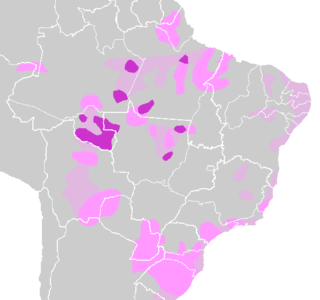Related Research Articles

Guaraní specifically the primary variety known as Paraguayan Guarani, is a South American language that belongs to the Tupi–Guarani family of the Tupian languages. It is one of the official languages of Paraguay, where it is spoken by the majority of the population, and where half of the rural population is monolingual. It is spoken by communities in neighboring countries, including parts of northeastern Argentina, southeastern Bolivia and southwestern Brazil, and is a second official language of the Argentine province of Corrientes since 2004; it is also an official language of Mercosur.

Guarani are a group of culturally-related indigenous peoples of South America. They are distinguished from the related Tupi by their use of the Guarani language. The traditional range of the Guarani people is in present-day Paraguay between the Uruguay River and lower Paraguay River, the Misiones Province of Argentina, southern Brazil once as far north as Rio de Janeiro, and parts of Uruguay and Bolivia.

Tupi–Guarani is the name of the most widely distributed subfamily of the Tupian languages of South America. It includes fifty languages, including the best-known languages of the family, Guarani and Old Tupi.
The Guarani languages are a group of half a dozen or so languages in the Tupi–Guarani language family. The best known language in this family is Guarani, one of the national languages of Paraguay, alongside Spanish.
Guarani, Guaraní or Guarany may refer to
The languages of Bolivia include Spanish; several dozen indigenous languages, most prominently Aymara, Quechua, Chiquitano and Guaraní; Bolivian Sign Language ; and language of immigrants such as Plautdietsch. Indigenous languages and Spanish are official languages of the state according to the 2009 Constitution. The constitution says that all indigenous languages are official, listing 36 specific languages, of which some are extinct. Spanish and Quechua are spoken primarily in the Andes region; Aymara is mainly spoken in the Altiplano around Lake Titicaca, Chiquitano is spoken in the central part of Santa Cruz and Guaraní in the southeast on the border with Paraguay.

Spanish is the language that is predominantly understood and spoken as a first, or second language by nearly all of the population of the Argentina. According to the latest estimations, the population is currently greater than 45 million.
Chiripá Guarani, also known as Ava Guarani and Nhandéva (Ñandeva), is a Guaraní language spoken in Paraguay, Brazil, and also Argentina. Nhandéva is closely connected to Mbyá Guaraní, as intermarriage between speakers of the two languages is common. Speakers of Nhandéva and Mbyá generally live in mountainous areas of the Atlantic Forest, from eastern Paraguay through Misiones Province of Argentina to the southern Brazilian states of Paraná, Santa Catarina, and Rio Grande do Sul. There are approximately 4,900 speakers in Brazil and 7,000 in Paraguay.
Mbya Guarani is a Tupi–Guarani language spoken by approximately 6,000 Brazilians, 3,000 Argentines, and 8,000 Paraguayans. It is 75% lexically similar to Paraguayan Guarani.
Eastern Bolivian Guaraní, known locally as Chawuncu or Chiriguano (pejorative), is a Guaraní language spoken in South America. In Bolivia 33,670 speakers were counted in the year 2000, in the south-central Parapeti River area and in the city of Tarija. In Argentina, there were approximately 15,000 speakers, mostly in Jujuy, but also in Salta Province, and 304 counted in the Paraguayan Chaco.
The Guaraní language belongs to the Tupí-Guaraní branch of the Tupí linguistic family.

The languages of South America can be divided into three broad groups:
Pãi Tavyterã is a Guarani language spoken by about 600 Pai Tavytera people in eastern Paraguay, in Amambay, eastern Concepción, eastern San Pedro, and northern Canindeyú Departments. The language has 70% lexical similarity with the Kaiwá language, spoken in Brazil. Among Pai Tavyetera people, language use is shifting towards Guaraní.

Chané is the collective name for the southernmost Arawakan-speaking peoples. They lived in the plains of the northern Gran Chaco and in the foothills of the Andes in Paraguay, Brazil, Bolivia, and Argentina. The historical Chané are divided into two principal groups. The Chané proper who lived in eastern Bolivia and the Guaná who lived in Paraguay and adjacent Brazil. Twenty-first century survivors of the Chané are the Izoceno people of Bolivia and 3,034 descendants reported in Argentina by the 2010 census. Survivors of the Guaná are the Tereno and the Kinikinao both of Mato Grosso do Sul province in Brazil.

Paraguayan Spanish is the set of dialects of the Spanish language spoken in Paraguay. In addition, it influences the speech of the Argentine provinces of Misiones, Corrientes, Formosa, and, to a lesser extent, Chaco. Paraguayan Spanish possesses marked characteristics of Spanish previously spoken in northern Spain, because the majority of the first settlers were from Old Castile and the Basque Country.
The Republic of Paraguay is a mostly bilingual country, where both Spanish, an Indo-European language in the Romance branch, and Guaraní, an indigenous language of the Tupian family, have official status.
Guarayu is a Tupian language of Bolivia that is spoken by the Guarayo people who number 23,910 in 2012.
Paraguayan Sign Language, or Lengua de señas paraguaya (LSPY), is the deaf sign language of Paraguay. It is not intelligible with neighboring languages, nor with American Sign Language, but speakers report that it has historical connections with Uruguayan Sign Language. It developed outside the schools, and was only used in education "recently".
The Spanish language is spoken in Bolivia by the majority of the population, either as a mother tongue or as a second language. Within the Spanish of Bolivia there are different regional varieties. In the border areas, Bolivia shares dialectal features with the neighboring countries.
References
- ↑ Western Bolivian Guarani at Ethnologue (18th ed., 2015)